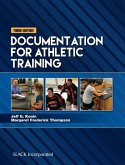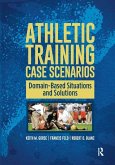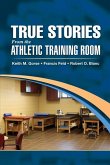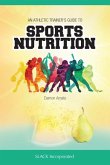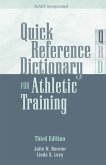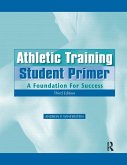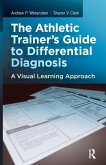- Broschiertes Buch
- Merkliste
- Auf die Merkliste
- Bewerten Bewerten
- Teilen
- Produkt teilen
- Produkterinnerung
- Produkterinnerung
For more than 15 years, Clinical Skills Documentation Guide for Athletic Training has been an invaluable resource for athletic training students to learn, practice, and master clinical skill sets throughout their educational career.
Andere Kunden interessierten sich auch für
![Documentation for Athletic Training Documentation for Athletic Training]() Jeff G. KoninDocumentation for Athletic Training93,99 €
Jeff G. KoninDocumentation for Athletic Training93,99 €![Athletic Training Case Scenarios Athletic Training Case Scenarios]() Keith GorseAthletic Training Case Scenarios82,99 €
Keith GorseAthletic Training Case Scenarios82,99 €![True Stories From the Athletic Training Room True Stories From the Athletic Training Room]() Keith GorseTrue Stories From the Athletic Training Room73,99 €
Keith GorseTrue Stories From the Athletic Training Room73,99 €![An Athletic Trainers' Guide to Sports Nutrition An Athletic Trainers' Guide to Sports Nutrition]() Damon AmatoAn Athletic Trainers' Guide to Sports Nutrition77,99 €
Damon AmatoAn Athletic Trainers' Guide to Sports Nutrition77,99 €![Quick Reference Dictionary for Athletic Training Quick Reference Dictionary for Athletic Training]() Julie N. BernierQuick Reference Dictionary for Athletic Training74,99 €
Julie N. BernierQuick Reference Dictionary for Athletic Training74,99 €![Athletic Training Student Primer Athletic Training Student Primer]() Andrew P. WintersteinAthletic Training Student Primer123,99 €
Andrew P. WintersteinAthletic Training Student Primer123,99 €![The Athletic Trainer's Guide to Differential Diagnosis The Athletic Trainer's Guide to Differential Diagnosis]() Sharon ClarkThe Athletic Trainer's Guide to Differential Diagnosis79,99 €
Sharon ClarkThe Athletic Trainer's Guide to Differential Diagnosis79,99 €-
-
-
For more than 15 years, Clinical Skills Documentation Guide for Athletic Training has been an invaluable resource for athletic training students to learn, practice, and master clinical skill sets throughout their educational career.
Hinweis: Dieser Artikel kann nur an eine deutsche Lieferadresse ausgeliefert werden.
Hinweis: Dieser Artikel kann nur an eine deutsche Lieferadresse ausgeliefert werden.
Produktdetails
- Produktdetails
- Verlag: Routledge
- 3. Auflage
- Seitenzahl: 662
- Erscheinungstermin: 15. Juni 2016
- Englisch
- Abmessung: 280mm x 216mm x 35mm
- Gewicht: 1637g
- ISBN-13: 9781617116193
- ISBN-10: 161711619X
- Artikelnr.: 54714782
- Herstellerkennzeichnung
- Libri GmbH
- Europaallee 1
- 36244 Bad Hersfeld
- gpsr@libri.de
- Verlag: Routledge
- 3. Auflage
- Seitenzahl: 662
- Erscheinungstermin: 15. Juni 2016
- Englisch
- Abmessung: 280mm x 216mm x 35mm
- Gewicht: 1637g
- ISBN-13: 9781617116193
- ISBN-10: 161711619X
- Artikelnr.: 54714782
- Herstellerkennzeichnung
- Libri GmbH
- Europaallee 1
- 36244 Bad Hersfeld
- gpsr@libri.de
John M. Hauth, EdD, LAT, ATC, is the Senior Director of Sports Medicine Relationships at St. Luke's University Health Network in Bethlehem, Pennsylvania. Prior to his retirement from academe in January 2015, John held appointments as a tenured faculty member, program director, and associate dean at East Stroudsburg University of Pennsylvania. The University bestowed its highest faculty honor of Distinguished Professor in May 2010. He had been previously recognized for teaching excellence by the Pennsylvania Academy for the Profession of Teaching. He was inducted into the Pennsylvania Athletic Trainers Hall of Fame in 2009. He is an active member of the National Athletic Trainers' Association, having been presented the Association's Most Distinguished Athletic Trainer Award and Professional Development Excellence Award. John has more than 30 years of experience as an athletic trainer, having worked in nearly every professional setting. He is licensed to practice as an athletic trainer by the PA State Board of Medicine and has been nationally certified (BOC) since 1983. He served as the Head Athletic Trainer for NCAA Division II Football and Division I Wrestling Teams from 1985 to 1997. John continues to work clinically as the Director of Athletic Training and Sports Medicine for the Lehigh Valley Steelhawks of the Professional Indoor Football League and at special events across the Lehigh Valley. In 2010, John served as a member of the Sports Medicine Staff for the XXI Central American and Caribbean Games in Mayaguez, Puerto Rico. John resides in East Stroudsburg, Pennsylvania, with his wife, Lynn. They have three children: daughter Amanda and sons Kendall and Connor. Brian M. Gloyeske, MS, LAT, ATC, is currently serving as an athletic trainer for St. Luke's University Health Network. He has practiced as a NATA BOC athletic trainer since 2010. Originally from Jackson Center, Ohio, Brian earned a Bachelor of Science in athletic training from the University of Toledo in 2010. He earned a Master of Science in athletic training from East Stroudsburg University of Pennsylvania in 2011, during which time he served as a graduate assistant athletic trainer at Warren Hills Regional High School, Washington, New Jersey. Before joining St. Luke's full time in 2015, he spent 4 years as an instructor in a CAATE-accredited athletic training program at East Stroudsburg University of Pennsylvania. During his time at East Stroudsburg University, he worked clinically with collegiate dancers and the general population of the University and oversaw and provided athletic training services to the East Stroudsburg Youth Association Athletics. In addition, Brian served as the head athletic trainer for the Lehigh Valley Steelhawks of the Professional Indoor Football League. Currently, Brian serves as an assistant athletic trainer for Moravian College in Bethlehem, Pennsylvania, and coordinates the secondary school concussion education program for St. Luke's University Health Network. Herbert K. Amato, DA, ATC, is currently an Associate Vice Provost at James Madison University (JMU) in Harrisonburg, Virginia. He was the Athletic Training Program Director at JMU from 1988 to 2006 and is still a tenured professor in the Department of Health Sciences. He has been actively involved in the education of athletic training students for 36 years at the university and high school levels. Dr. Amato has an extensive public speaking and consulting background and has published several articles in the areas of athletic training education and clinical practice. He was inducted into the Virginian Athletic Trainers' Hall of Fame in 2012. He is an active member of the National Athletic Trainers' Association, and has been presented the Association's 2003 Sayers "Bud" Miller Distinguished Educator Award. Dr. Amato was the lead author for the first two editions of this book; however, he believes the now-lead authors are able to better portray the current needs of the profession. As co-founder of ACES, a preparatory workshop company that helps prepare students to take the BOC exam, Dr. Amato has stayed current in the field by developing assessment exams that mimic the blueprint of the national exam. In his current position, he is the chair of the Assessment Advisory Council and was the co-chair of the University-wide 10-year reaffirmation for The Southern Association of Colleges and Schools Commission on Colleges. This commission is the regional accreditor for JMU. Dr. Amato is also active in service at the community, university, and national levels. He resides in Harrisonburg, Virginia, with his wife, Lori. They have three grown daughters, Casey, Lyndy, and Jessy.
Dedication Acknowledgments About the AuthorsIntroduction Section I
Introduction Chapter 1 Certification of Athletic Trainers and the Evolution
of Psychomotor Skill Assessment Chapter 2 How to Use This Book Section II
Prevention and Health Promotion Chapter 3 Prevention and Health Promotion
Section III Clinical Examination and Diagnosis Chapter 4 Musculoskeletal
System-Region 1: Foot and Toes Chapter 5 Musculoskeletal System-Region 2:
Ankle and Lower Leg Chapter 6 Musculoskeletal System-Region 3: Knee Chapter
7 Musculoskeletal System-Region 4: Hip and Pelvis Chapter 8 Musculoskeletal
System-Region 5: Lumbar and Thoracic Spine Chapter 9 Musculoskeletal
System-Region 6: Cervical Spine Chapter 10 Musculoskeletal System-Region 7:
Shoulder Chapter 11 Musculoskeletal System-Region 8: Elbow Chapter 12
Musculoskeletal System-Region 9: Wrist and Hand Chapter 13 Musculoskeletal
System-Region 10: Head and Face Section IV Acute Care of Injuries and
Illnesses Chapter 14 Acute Care of Injuries and Illnesses Section V
Therapeutic Interventions Chapter 15 Therapeutic InterventionsAppendix
Self-Reporting Assessment of Athletic Training
CompetenciesBibliographyFinancial Disclosures
Introduction Chapter 1 Certification of Athletic Trainers and the Evolution
of Psychomotor Skill Assessment Chapter 2 How to Use This Book Section II
Prevention and Health Promotion Chapter 3 Prevention and Health Promotion
Section III Clinical Examination and Diagnosis Chapter 4 Musculoskeletal
System-Region 1: Foot and Toes Chapter 5 Musculoskeletal System-Region 2:
Ankle and Lower Leg Chapter 6 Musculoskeletal System-Region 3: Knee Chapter
7 Musculoskeletal System-Region 4: Hip and Pelvis Chapter 8 Musculoskeletal
System-Region 5: Lumbar and Thoracic Spine Chapter 9 Musculoskeletal
System-Region 6: Cervical Spine Chapter 10 Musculoskeletal System-Region 7:
Shoulder Chapter 11 Musculoskeletal System-Region 8: Elbow Chapter 12
Musculoskeletal System-Region 9: Wrist and Hand Chapter 13 Musculoskeletal
System-Region 10: Head and Face Section IV Acute Care of Injuries and
Illnesses Chapter 14 Acute Care of Injuries and Illnesses Section V
Therapeutic Interventions Chapter 15 Therapeutic InterventionsAppendix
Self-Reporting Assessment of Athletic Training
CompetenciesBibliographyFinancial Disclosures
Dedication Acknowledgments About the AuthorsIntroduction Section I
Introduction Chapter 1 Certification of Athletic Trainers and the Evolution
of Psychomotor Skill Assessment Chapter 2 How to Use This Book Section II
Prevention and Health Promotion Chapter 3 Prevention and Health Promotion
Section III Clinical Examination and Diagnosis Chapter 4 Musculoskeletal
System-Region 1: Foot and Toes Chapter 5 Musculoskeletal System-Region 2:
Ankle and Lower Leg Chapter 6 Musculoskeletal System-Region 3: Knee Chapter
7 Musculoskeletal System-Region 4: Hip and Pelvis Chapter 8 Musculoskeletal
System-Region 5: Lumbar and Thoracic Spine Chapter 9 Musculoskeletal
System-Region 6: Cervical Spine Chapter 10 Musculoskeletal System-Region 7:
Shoulder Chapter 11 Musculoskeletal System-Region 8: Elbow Chapter 12
Musculoskeletal System-Region 9: Wrist and Hand Chapter 13 Musculoskeletal
System-Region 10: Head and Face Section IV Acute Care of Injuries and
Illnesses Chapter 14 Acute Care of Injuries and Illnesses Section V
Therapeutic Interventions Chapter 15 Therapeutic InterventionsAppendix
Self-Reporting Assessment of Athletic Training
CompetenciesBibliographyFinancial Disclosures
Introduction Chapter 1 Certification of Athletic Trainers and the Evolution
of Psychomotor Skill Assessment Chapter 2 How to Use This Book Section II
Prevention and Health Promotion Chapter 3 Prevention and Health Promotion
Section III Clinical Examination and Diagnosis Chapter 4 Musculoskeletal
System-Region 1: Foot and Toes Chapter 5 Musculoskeletal System-Region 2:
Ankle and Lower Leg Chapter 6 Musculoskeletal System-Region 3: Knee Chapter
7 Musculoskeletal System-Region 4: Hip and Pelvis Chapter 8 Musculoskeletal
System-Region 5: Lumbar and Thoracic Spine Chapter 9 Musculoskeletal
System-Region 6: Cervical Spine Chapter 10 Musculoskeletal System-Region 7:
Shoulder Chapter 11 Musculoskeletal System-Region 8: Elbow Chapter 12
Musculoskeletal System-Region 9: Wrist and Hand Chapter 13 Musculoskeletal
System-Region 10: Head and Face Section IV Acute Care of Injuries and
Illnesses Chapter 14 Acute Care of Injuries and Illnesses Section V
Therapeutic Interventions Chapter 15 Therapeutic InterventionsAppendix
Self-Reporting Assessment of Athletic Training
CompetenciesBibliographyFinancial Disclosures


